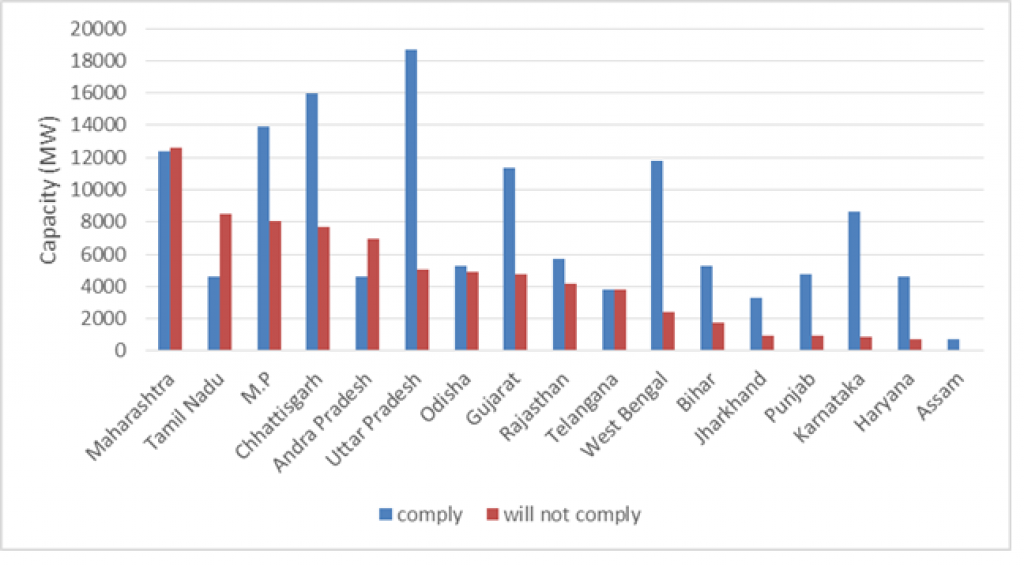

State-run stations in these states will default emission norms, finds CSE analysis



The Union Ministry of Environment, Forest and Climate Change (MoEF&CC) recently revised deadlines for coal-based thermal power stations to meet tighter emission norms. The deadlines have been delayed once again with plants disaggregated into three categories: A, B and C.
The final categorisation list was disclosed by MoEF&CC and the Central Pollution Control Board (CPCB) on December 13, 2021, almost eight months after the amendment was issued.
The analysis by the Centre for Science and Environment (CSE), a Delhi-based non-profit, of the current status of emission norms (as reported by CEA) showed that 61 per cent coal thermal power capacity in Category A, 35 per cent capacity in Category B and 32 per cent capacity in Category C will not be able to meet deadlines even in 2022.
The major defaulters belong to the following states: Maharashtra, Tamil Nadu, Madhya Pradesh, Chhattisgarh and Andhra Pradesh. These defaulting stations are run largely by the respective state governments.
Major defaulters
At least 17 Indian states have coal-based thermal power stations. A state-wise comparison highlighted the following:
 State-wise emission norms compliance status for coal thermal power plants (Source: CEA)
State-wise emission norms compliance status for coal thermal power plants (Source: CEA)
State-run units on the wrong
A majority of the coal thermal power capacity that is likely to meet the norms belongs to the central sector followed by the private sector. Among the plants belonging to the state sector, some have floated the tender or at various stages of a feasibility study or simply have not framed any action plan to date.
Only 6 per cent of this capacity has awarded tender and no plant has so far commissioned flue-gas desulfurization.
In states such as Bihar, Uttar Pradesh, Telangana, Tamil Nadu, Chhattisgarh, Odisha and Andhra Pradesh, 45-70 per cent of the power capacity that will comply with the new emission norms as scheduled is run by NTPC Ltd.
NTPC and its subsidiaries account for 27 per cent of the total power capacity. It is the highest coal power capacity that is owned by any single entity.
At least 83 per cent of NTPC coal thermal power capacity will meet the deadlines. NTPC has already awarded the bid for 75 per cent of the capacity owned by it. NTPC may, in fact, meet the due deadlines earlier for 64 per cent of the capacity.
| Plants owned by NTPC (and subsidiaries) that have awarded tender | ||||
| Category | Capacity (MW) | % capacity | Revised Deadlines | Could meet the deadline |
| A | 6,480 | 12 | 2022 | 2022 |
| B | 4,260 | 8 | 2023 | 2022 |
| C | 31,460 | 56 | 2024 | 2022 |
Among other major coal thermal power developers, the power plants owned by Telangana State Power Generation Corporation Ltd, Tamil Nadu Electricity Board, Andhra Pradesh Power Generation Corp and Haryana Power Generation Corporation Ltd will miss the deadline.
These are all state-run power companies.
Karnataka Power Corporation Ltd (state-run) and Reliance Power (private) are the only two developers that will 100 per cent comply with the deadlines.
For Maharashtra State Power Generation Company and Madhya Pradesh Power Generation Company Ltd (state-run), only 50 per cent of the capacity will be able to meet the deadline in time.

Developer-wise emission norms compliance status for coal thermal power plants (Source: CEA)
Can penalty drive the non-complying units to compliance?
The April 2021 notification also introduced a penalty mechanism or environmental compensation for plants that will not meet the respective deadlines, in addition to revising the deadlines.
The briefing note in April 2021 said: “Thermal power plants (TPP) enjoying three-year extension (Category C) are liable to pay the least compensation, 5-10 paisa a unit, starting 2025. Those with two-year extension (Category B) have to pay 7-15 paisa a unit starting 2024, and those stations that have to meet the norms by next year have to pay the highest penalty of 10-20 paisa a unit starting 2023 on default”.
The penalty imposed on non-compliant units will be more feasible to pay rather than bearing the legalised cost of retrofit of pollution control equipment to meet the new norms.
Environmental governance heading towards dangerous trend
This was the third time that the MoEF&CC revised deadlines to accommodate the coal thermal power plants. As Down to Earth established earlier in our previous analysis, 35 per cent of the total coal power will fail to meet their respective deadlines to meet the new emission norms.
The environmental compensation that will be levied too will fail to act as deterrence for this expected non-compliance as it is too meagre as compared to the cost of effective emission control by a coal thermal power plant.
It has been six years since the new emission norms for coal power thermal plants were introduced, but we are still facing resistance in its implementation.
Nivit Kr Yadav, director, industrial pollution unit, CSE, said environmental governance is heading towards a dangerous trend, where it is wrongly perceived by polluting industries that any non-compliance can be ‘paid-off’.
“Polluter pays principle” instead of acting as a deterrent, is being misused by some industries to ‘pay their way through’ despite repeated non-compliance. The policymakers need to initiate a dialogue on how we want environmental governance to be like.
We are a voice to you; you have been a support to us. Together we build journalism that is independent, credible and fearless. You can further help us by making a donation. This will mean a lot for our ability to bring you news, perspectives and analysis from the ground so that we can make change together.
India Environment Portal Resources :

Comments are moderated and will be published only after the site moderator’s approval. Please use a genuine email ID and provide your name. Selected comments may also be used in the ‘Letters’ section of the Down To Earth print edition.